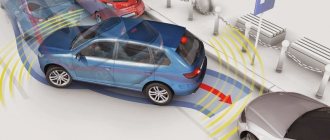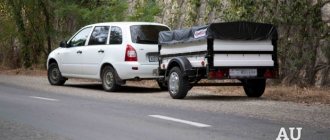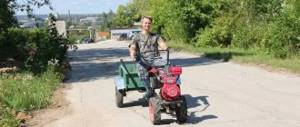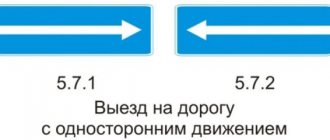General rules for towing a trailer hitch
Motorists often travel with trailers at speeds of 140 km/h. Which is not acceptable, but unfortunately happens. Manufacturers recommend sticking to speeds of up to 100 km/h. Decoding the traffic rules looks like this:
- When driving on a motorway without a towed device, the speed limit is 110 km/h. With a trailer, the maximum speed is no higher than 90.
- On other roads outside populated areas without a trailer - 90 km/h, with a trailer - 70 km/h.
- In populated areas, the traffic limit for all vehicles is 60 km/h.
The fine for speeding varies from 500 to 5000 rubles. As well as deprivation of a driver’s license from 4 to 6 months for the first incident and up to 1 year for a second incident, if the violation for speeding is 60-80 km/h. According to traffic regulations, it is prohibited to transport passengers in a trailer, semi-trailer, or caravan trailer. It is prohibited to drive a road train without connecting electrical devices of the trailer to the vehicle, trailer hitch and safety cables. The road sign “driving with a trailer is prohibited” prohibits the movement only of trucks over 3.5 tons, tractors, and self-propelled vehicles.
The meaning of the reaction and compliance with the main rule
There is such a thing as reaction speed. In our case, we are talking about the driver’s reaction speed to what is happening around him. Moreover, for different people, depending on various factors, the reaction may differ significantly.
For some, a split second is enough to react to changes in movement. Others spend up to several seconds on this. And there is a direct pattern here. The higher the current speed of the vehicle, the further the distance the car will have to travel before the driver has time to react. And the lower the speed, the higher the probability for the driver to have time to react, make a decision and make a maneuver to avoid an accident, accident or other incident.
As for the main rule, everything is extremely simple. Every driver is obliged to think about compliance with safety measures. This affects him directly, as well as other road users.
Rules for avoiding trailer skidding
Driving pattern when turning with a trailer
When turning or bending the road, pressing too hard to the left edge of your lane will fold the trailer in half. Such a trip to the country results in dents on the car, deformation of the trailer fender, and loss of cargo. In fact, the turning arc of a vehicle with a towed device is wider. Therefore, when turning, you should leave more lateral space. That is, if you turn left, you need to go in an arc to the right. And vice versa. But if there is a skid, the trailer overturns.
The most common mistake is braking while turning. But the trailer does not like this and does not forgive. You need to take turns with a towed device at a stable speed, without reducing or increasing it, otherwise it will drag the car to the side.
The picture becomes clearer: you need to slow down and turn.
But what to do if the trailer still starts to sway from side to side? It's simple, you just need to add speed:
- Enter the turn.
- Press the gas pedal. There will be no skidding.
General rules
If you act in accordance with the traffic rules, observing the set speed of the vehicle together with the trailer, the risk of getting into an accident or becoming a participant or culprit in an accident is significantly reduced.
This applies not only to compliance with the speed limit. The basic rules for driving with a trailer include the following points:
- Depending on the load capacity of the trailer, in order to tow it with a car, the driver must have an open category B, C or D.
- Motorists with category B are allowed to drive a vehicle with a trailer of category O1, that is, with a weight of up to 750 kilograms. In this case, the total weight of the road train should not exceed 3500 kg.
- A trailer, whether made by hand or purchased from a manufacturer, must have marker lights, turn signals and brake lights. All lighting equipment must be in good condition.
- To pull a trailer behind you, a towing device, or simply a towbar, is installed on the vehicle. They are removable and non-removable. It is better to choose the first option.
- When driving a car without a trailer, the tow ball must be removed.
- If the dimensions of the trailer are larger than those of the car, then additional rear-view mirrors must be installed on the car. Enlarged holders are provided for them. This allows you to control what is happening behind the car.
- When transporting a trailer, you must have chocks to support the wheels on the trailer. This is relevant for situations when you are forced to stop on a road with a slope.
- Trailers of categories O2 and O3 must be equipped with a braking system.
- It is strictly forbidden to transport people in trailers, regardless of their type.
- Speed limits must be strictly observed.
- Separate registration documents are required for the trailer. Their presence with the driver when traveling is mandatory.
There are separate requirements for cargo transported on a trailer.
Load distribution when driving with a trailer
You cannot transport cargo that:
- interferes with the driver’s normal view of the road;
- interferes with maneuvering and control;
- closes warning devices on the trailer;
- covers license plates;
- exceeds the permissible dimensions of the road train;
- creates obstacles and hindrances for other transport;
- affects the vehicle's stability.
As you can see, there are quite a lot of rules, and they are extremely strict. Any violation entails not just the risk of getting a fine, but also the possibility of facing more serious consequences in the form of an accident, loss of cargo, damage to property, or breakdown of your own trailer or car.
Before you set off, please consider the following:
- when driving as part of a road train (vehicle plus trailer), the braking distance increases noticeably compared to driving without a trailer;
- the speed increase will be slower than usual;
- the trailer is characterized by inertia, that is, when the vehicle brakes, it continues to move without having its own braking system;
- the total length of the road train increases;
- the trailer may skid if driven carelessly;
- If necessary, the trailer can be uncoupled and parked manually.
At the same time, drivers often ignore these recommendations and violate the rules. One of the consequences is skidding.
Reverse parking rules
Manual installation into a parking space is suitable when parking with a car is excluded due to load capacity or lack of turning. It's not that easy to park in reverse with a trailer. To do this, you need to break the trajectory of the trailer. If the gate is on the left, then the first action should be “steer to the right.” Then the rear bumper goes to the right and the trailer to the left. Then turning the steering wheel in the opposite direction will ensure movement in a smooth arc. If you turn the steering wheel a lot, the road train will fold. To prevent this from happening, you need to turn the steering wheel faster.
A general rule for all drivers: you cannot start driving a trailer in reverse if the situation behind the towed vehicle is unknown. The assistance of a partner is often necessary to control maneuvering.
Basic rules for driving a car with a trailer
The rules for using a trailer are the same for each driver:
- First of all, you should take care of securing the trailer as securely as possible. Practice shows that the cause of an emergency situation, when the towed unit becomes detached at full speed, can be precisely the negligence of the car owner, who did not take care of securing it. It is best to attach a trailer after first reading the user manual for the specific design.
- The trailer's light signals must be in good working order, because in this case the role of the rear markers and turn signals will be played by the lights on the rear of the trailer. The connection of these elements with the on-board control panel must be reliably and correctly synchronized.
Thus, it is the quality and correctness of the connection of the trailer to the vehicle that determines the safety of all road users. Also, compliance with these simple rules will eliminate any conflicts with the traffic police that arise when checking a car or during an accident (even not through the fault of the trailer owner). Another simple rule for resolving issues related to the operation of a trailer on the road and ownership rights to it is mandatory registration with the registration department of the State Traffic Safety Inspectorate (SAI).
Preparing for the trip, inspection and loading
Trailer loading diagram
Typically, problems with a trailer begin when loading. The correct weight distribution is 60% to 40%. Sixty ahead, forty behind. The center of gravity of the load must be placed lower and closer to the axis. If the front is overloaded, the drawbar will put a lot of pressure on the tow bar. Then the unloaded front axle of the car will become less responsive to the steering wheel. And an overloaded trailer feed reduces the effectiveness of the rear brakes of the tractor. It is easier to drive a road train when the vehicle is loaded more than the trailer. In the worst case scenario, if it is empty, it is better to transfer part of the load into it.
Before each departure you need to check:
- Reliability of the coupling.
- Fastening of all wheels.
- Tire pressure. It must correspond to the factory values, have a difference of no more than 0.1 atmospheres between each other. It is advisable to increase the pressure in the rear wheels of the car by 0.2 atmospheres from the norm.
- Safety rope.
- Released brake lever.
- Lighting equipment indication. Connect the plug to the towbar socket with the lights turned off.
Speed limits and trailers
Now it’s worth talking directly about what speed limits exist for passenger cars that have an additional trailer attached to their rear.
In total, we can highlight several main restrictions prescribed in the traffic rules. Some of them apply specifically to trailers:
- Living sector. If there is a Residential Zone sign, which I talked about in more detail in the article at the link, then moving faster than 20 km per hour is prohibited;
- Towing a car. There are situations when you have to take another car in tow. There is also a maximum speed limit of 50 kilometers per hour;
- Trailer in the city. There are no changes here compared to a passenger car without a trailer. The same 60 kilometers per hour is allowed in the city;
- Outside the city, but with a trailer. And here is the first obvious difference. If an ordinary car is allowed 90 kilometers per hour, then the trailer immediately reduces the maximum speed to 70 kilometers per hour;
- Highway and trailer. 20 are also subtracted from the standard limit, resulting in only 90 kilometers per hour. It is prohibited to exceed this limit. Plus it's dangerous.
See also
Dimensions of the trunk of a Lada Largus car: volume and dimensions
But these are quite general figures, although they are prescribed in traffic rules.
To understand exactly how fast and where you can drive, you should focus on road signs and markings.
see also
Why the steering wheel does not return to its original position: eliminating the reasons
Fine for a trailer without documents
Trailer without registration. For citizens, the fine for such a violation is up to 800 rubles. Proof of registration is the license plate number and PTS.
No numbers. For this, the inspector will fine you up to 5,000 rubles or deprive you of your license for up to 3 months.
No required category. If there is no open category for driving a car with a trailer, the fine is up to 15,000 rubles.
The legal entity's trailer is not insured. In 2021, the Supreme Court decided not to apply the MTPL law to owners of passenger trailers. This is also written in paragraph “e” of Part 3 of Art. 4 laws on compulsory motor liability insurance. An insurance policy for a trailer is only required if the vehicle is registered to a company. The fine for not having an MTPL policy is 800 rubles.
Conditions for using trailers weighing more than 750 kg
In 2021, licenses will be required not only for a trailer for a passenger car, but also for a trailer. Category “B”, according to the traffic rules, gives the right to drive cars and small trucks, SUVs (jeeps), minibuses, sidecars, vehicles with trailers with a maximum permitted weight of up to 0.75 tons. If this figure is more than 750 kg, then such a vehicle composition must meet the additional requirements specified in Art. 25 196-FZ for 2021:
- The permissible maximum weight of the trailer must not be greater than the unladen weight of the vehicle.
- The sum of the permitted maximum weight of both vehicles should not exceed 3.5 tons.
- If these criteria are not met, the driver will need to obtain category “BE” on a new driver’s license.
Rules for driving a trailer
When driving on the road with a car with a trailer, it is important to remember some nuances. With a trailer, not only the length of the car increases, but its weight
Naturally, this will affect the movement - the speed will take much longer to gain, and, accordingly, it will take more time to accelerate. It is especially important to take this fact into account when deciding to overtake another vehicle. It is clear that returning to your lane with a trailer will be more difficult than without it. That’s why it’s better not to take risks and try, after all, not to overtake cars ahead unless necessary.
When driving a car with a trailer, you need to slow down and press to the right when overtaking a large truck, otherwise the air flow emanating from the large vehicle will push the trailer to the side, and it is unknown how much. So the consequences can be unpredictable.
During the entire route, it is necessary to monitor the trailer: there should be no jerking, wobbling, or jumping. If it behaves this way, the towbar may be worn out, the load may be improperly distributed, or the tire pressure may be uneven.
It is also important to monitor the wheels of the trailer: when unloaded, you may not feel that the tire has been punctured, but driving for a long time with a flat tire can lead to their complete failure.
You need to turn very carefully. You should not brake when entering a turn, but you need to leave a margin of at least one and a half meters from the curb to the car so that the trailer does not skid
You also need to maintain a stable speed, otherwise the trailer will pull the car to the side. In general, it is better to slow down before turning, then carefully maneuver and continue moving. If the trailer still behaves unstable when turning, you need to accelerate a little (acceleration, according to physical laws, helps to dampen the vibrations).
Driving on country roads requires even greater vigilance. It is better to avoid high speeds and sharp turns, because the trailer needs to go along the same track of the dirt road along which the car itself is moving.
When driving in reverse with a trailer, you must be especially careful. The first thing you need to remember is that the steering wheel should be turned in the direction opposite to where the van is turning. It makes sense to try this maneuver in a safe place before you end up on the road with the load.
Keep your distance! Most trailers do not have brakes, which means that the braking distance of such a vehicle will be increased. For example, if the road is good and the speed is 70 kilometers per hour, the braking distance of a car with a trailer will be eight meters.










